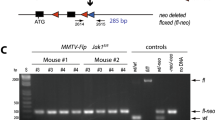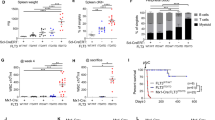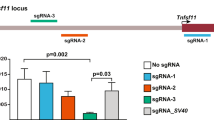Abstract
The yeast-derived Flp-frt site-specific DNA recombination system was used to achieve pituitary-specific inactivation of the retinoblastoma (Rb) tumor suppressor gene. Whereas mice carrying only frt sites in both alleles of Rb remain tumor free, tumorigenesis ensues when the Flp recombinase is expressed. The rate of tumorigenesis in these mice depends both on the expression level of the Flp recombinase and on the presence of frt sites in one or both Rb alleles. This permitted a more accurate definition of the consecutive steps in pituitary tumorigenesis. Our study illustrates the potential of this approach for studying sporadic cancer in a defined mouse model.
This is a preview of subscription content, access via your institution
Access options
Subscribe to this journal
Receive 50 print issues and online access
$259.00 per year
only $5.18 per issue
Buy this article
- Purchase on Springer Link
- Instant access to full article PDF
Prices may be subject to local taxes which are calculated during checkout
Similar content being viewed by others
Author information
Authors and Affiliations
Rights and permissions
About this article
Cite this article
Vooijs, M., van der Valk, M., Riele, H. et al. Flp-mediated tissue-specific inactivation of the retinoblastoma tumor suppressor gene in the mouse. Oncogene 17, 1–12 (1998). https://doi.org/10.1038/sj.onc.1202169
Received:
Accepted:
Published:
Issue Date:
DOI: https://doi.org/10.1038/sj.onc.1202169
Keywords
This article is cited by
-
NEMO- and RelA-dependent NF-κB signaling promotes small cell lung cancer
Cell Death & Differentiation (2023)
-
Retinoblastoma protein (RB) interacts with E2F3 to control terminal differentiation of Sertoli cells
Cell Death & Disease (2014)
-
Skp2 is required for survival of aberrantly proliferating Rb1-deficient cells and for tumorigenesis in Rb1+/− mice
Nature Genetics (2010)
-
Combinations of genetic mutations in the adult neural stem cell compartment determine brain tumour phenotypes
The EMBO Journal (2010)
-
The retinoblastoma tumor-suppressor gene, the exception that proves the rule
Oncogene (2006)



